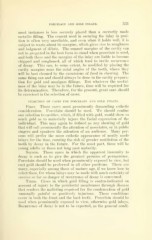Page 673 - My FlipBook
P. 673
PORCELAIN AND GOLD INLAYS. 331
most instances is less securely placed than a con*ectly made
metallic filling. The cement used in securing the inlay in posi-
tion is often very unreliable, and even when it holds well, it is
subject to waste about its margins, which gives rise to roughness
and lodgment of debris. The enamel margins of the cavity can
not be prepared in the best form to stand when porcelain is used,
and both these and the margins of the inlay are liable to become
chipped and roughened, all of which tend to invite recurrence
of decay. This can, to some extent, be modified by placing the
cavity margins near the axial angles of the teeth, where they
will be best cleaned by the excursions of food in chewing. The
same thing can and should always be done in the cavity prepara-
tion for gold and amalgam fillings. But whatever the useful-
ness of the inlay may be in the future, time will be required for
its determination. Therefore, for the present, great care should
be exercised in the selection of cases.
SELECTION OF CASES FOE PORCELAIN AND GOLD INLAYS.
First. Those cases most prominently demanding esthetic
consideration. Porcelain should be used. We should confine
our selection to cavities, which, if filled with gold, would show so
much gold as to materially injure the facial expression of the
individual. This may again be defined as any showing of gold
that will call prominently the attention of associates, or in public
singers and speakers the attention of an audience. Many per-
sons will prefer the more esthetic appearance of neatly made
inlays for the time, running the risk of greater mutilation of the
teeth by decay in the future. For tlie most part, these will be
young adults or those not long past maturity.
Second. Those cases in which the apparent immunity to
decay is such as to give the greatest promise of permanence.
Porcelain should be used when iirominently exposed to view, but
cast gold should be preferred in all other positions. There are
many, especially among those of mature age, if we know how to
select them, for whom inlays may be made with much certainty of
success so far as danger of recurrence of decay is concerned.
Third. Cases in which gold filling is contra-indicated on
account of injury to the peridental membranes through disease
that renders the malleting required for the condensation of gold
unusually painful or positively injurious. These conditions
occur in both the front and the back teeth. Porcelain should be
used when prominently exposed to view, otherwise gold inlays.
Eecurrence of decay is not to be expected, as the general condi-


